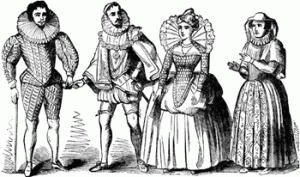 The themes of marriage and same-sex relationships in Shakespeare’s The Merchant of Venice warrant the discussion of same-sex marriage. While there is no explicit condoning of same-sex marriage, Arthur L. Little argues that the concept of same-sex relationships is used to challenge the very institution of marriage within the play.
The themes of marriage and same-sex relationships in Shakespeare’s The Merchant of Venice warrant the discussion of same-sex marriage. While there is no explicit condoning of same-sex marriage, Arthur L. Little argues that the concept of same-sex relationships is used to challenge the very institution of marriage within the play.
In his essay, “the Rites of Queer Marriage in The Merchant of Venice,” Little deconstructs the motivations behind heterosexual marriage in the context of this Shakespeare comedy. Citing specifically the casket games of Portia’s father, the author argues that the demand of marriage is a way of avoiding death. Specifically, ensuring that one’s children get married and reproduce also ensures that the person lives on through his offspring. In this context, Little describes heterosexual marriage as “the ritualistic rejection of mourning” (218). He emphasizes the importance placed upon transference in marriage: the transfer of a dowry from one family to another, of a name from parent to child, of wealth and land from generation to generation. All of these transactions legitimize and necessitate the institution of heterosexual marriage as an indistinguishable part of society and life, and it is through these processes that a man, or father, can “live on” in society even after death.
In the world of The Merchant of Venice, reaching immortality via the marriage (and subsequent procreation) of one’s children appears to be the ultimate goal. Little calls attention to the fact that this goal requires the acceptance of one’s inevitable death. Thus, in a way, by functioning within the societal institution of heterosexual marriage, one is focusing entirely on the future after s/he is dead. This is not the case for the relationship of Antonio and Bassanio, however. Little argues that this relationship “takes on heterosexual marriage at its most sacrosanct sites and proceeds to outstrip each of them” (221). Because a same-sex relationship does not result in the transference of wealth or the continuation of a lineage, the societally established motivations for marriage cannot apply.
Of course, at this time, the very concept of same-sex marriage is socially unheard of. Nevertheless, Little emphasizes that Antonio and Bassanio challenge the societal ties of marriage even without their relationship necessarily being romantic or sexual. He discusses the importance of friendship within the society of The Merchant of Venice, equating it to the establishment of kinship that was “not entered into lightly,” not unlike the process of a marriage creating a kinship (221). Though both relationships share a similar level of importance, (heterosexual) marriage was still considered a very public affair. Contrarily, Little argues, the explicit establishment of a (same-sex) friendship was “personal and private” (221). As such, same-sex relationships, as demonstrated by Antonio and Bassanio, effectively separated a marriage-type relationship from the societal institution.
This separation challenges the very idea of marriage, which initially could not exist without societal structures in place. However, this does not change the fact that heterosexual marriage is still the only marriage, which evokes Antonio’s sadness. As Little points out, Antonio recognizes that he “must play a part / And [his] a sad one” (1.1.78-79). Through this lens, Antonio’s sad role is not only an expression of personal mourning for a societally unobtainable relationship, but a challenge to the “rejection of mourning” that is heterosexual marriage.
Little, Arthur L. “The Rites of Queer Marriage in The Merchant of Venice.”Shakesqueer. Ed. Madhavi Menon. Durham, NC: Duke University Press, 2011. 216-224. Print.
